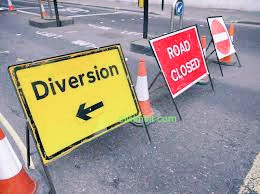In this article I will describe how to divert traffic during road construction.

Traffic diversion allows traffic to flow safely and efficiently in and around construction sites while protecting road construction workers and equipment. In addition, they provide continuity for motor vehicle, bicycle and pedestrian travel, transit traffic, and access to property and utilities.
Traffic diversion can be divided into two main types.
- Passage of Traffic on the Existing Carriageway under Improvement
- Passage of Traffic along with a Temporary Diversion
Now We will discuss these two types of traffic diversion in detail.
Table of Contents
1. Passage of Traffic on the Existing Carriageway under Improvement
- If part of an existing roadway is used for traffic, the shoulder should be treated on the non-constructed side.
- The shoulder must be treated with a granular base course of minimum 150 mm thickness covered with a bituminous surface treatment of minimum width 1.5 m and the surface must be maintained by the traffic will during use.
- The continuous length over which road works are carried out is limited to 500 m at one point.
- However, if work over longer distances is permitted, overtaking opportunities should be provided with an additional pavement width of 2.5 m for every 0.5 km.
- If the existing 2 lanes are to be extended to his 4 lanes, then the existing lanes must be treated after building the additional 2 lanes to divert traffic.
- Treated shoulders constructed to divert traffic will be removed, debris cleared and the area cleared.
2. Passage of Traffic along with a Temporary Diversion
Temporary detours should be established on road segments where traffic cannot pass through that portion of the roadway. The temporary detour consists of a 7m carriageway with 2.5m dirt shoulders on each side (12m total carriageway width) and a 7m wide pavement with the following provisions:
- 200 mm (compacted) granular subsoil
- 225 mm (compressed) grain base course
- Premix carpet with seal coat/mix seal surfacing
Detour routing and traversal including junctions and temporary cross drains.
Traffic safety and Management
A coordinated phased program for highway traffic diversion should be planned before construction work begins.
All necessary traffic safety measures during road construction are to install barriers such as flags, lights, signs, markers, flag bearers, etc. to protect and inform traffic passing through or approaching the improved section of the highway.
Barricades must be sturdy enough to withstand injury and must have alternating black and white stripes on both sides of the lane/part of the lane that is closed to traffic.
At night, place red lanterns or warning lights on the barricades and keep them on continuously from sunset to sunrise.
Places where traffic must deviate from the normal lane, the fairway, must be clearly marked with the help of painted drums or lane markings.
At night, walkways should be illuminated with lanterns or other suitable light sources.A one-way street must be formed when traffic must pass through a section of the highway that is insufficient for two-lane traffic.
This is accomplished with the help of temporary traffic lights or flag bearers who are always stationed on the other side.Flag bearers must carry green and red flags and lanterns/lights for traffic control.
Appropriate regulatory/warning signs must be posted on both sides to help road users find the way.
Each access must post at least two signs. One near the point where the lane transition begins and another 120m away.
Development of detours and traffic control systems
Signs, barriers, signals, other traffic control devices, and running surfaces of detours shall be maintained in satisfactory condition until the detour is used for traffic. Temporary roots should be kept dust-free by frequent water spraying.
